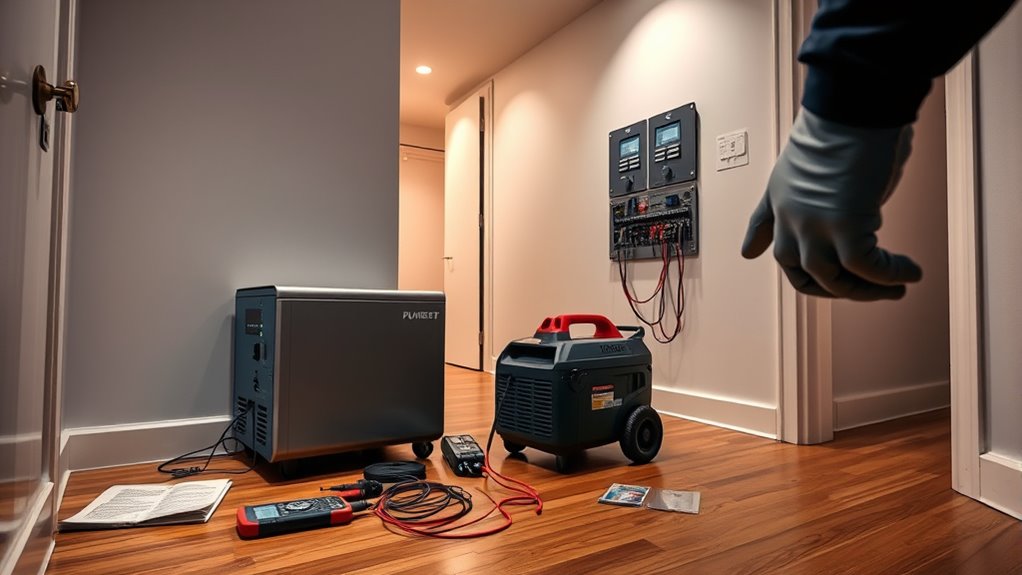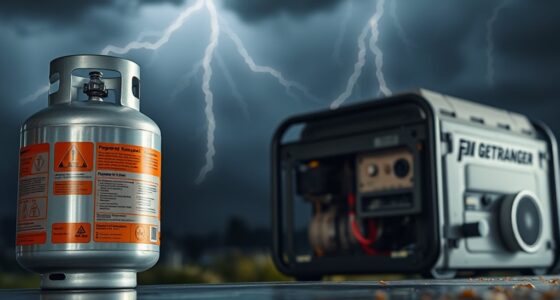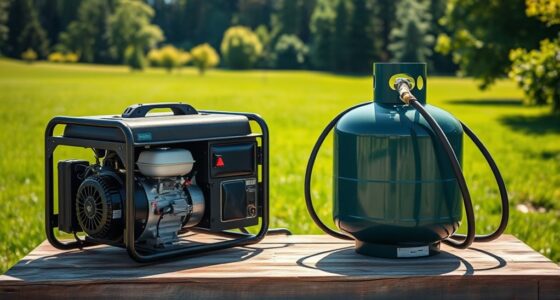To troubleshoot your apartment backup power system effectively, start by understanding its basics and regularly checking connections for corrosion or damage. Keep an updated inventory of your equipment, test the system under load periodically, and know the proper way to reset and restart it safely. Watch for common signs like flickering or tripped breakers, and have a clear emergency plan in place. Stay informed, and you’ll be better prepared for any outages—more tips await if you continue.
Key Takeaways
- Regularly inspect and maintain your backup power system, including cables, connections, and equipment, to ensure reliability during outages.
- Test your system periodically with controlled simulations, and follow proper reset procedures to prevent damage and ensure proper functioning.
- Identify and resolve common signs of issues like flickering lights, breaker trips, or unusual noises early to avoid system failure.
- Develop a clear emergency backup plan, including safe switching procedures and communication with neighbors or management.
- Prioritize safety by following manufacturer instructions, waiting after power off before restarting, and confirming overloads are resolved.
Understand Your Backup Power System’s Basics
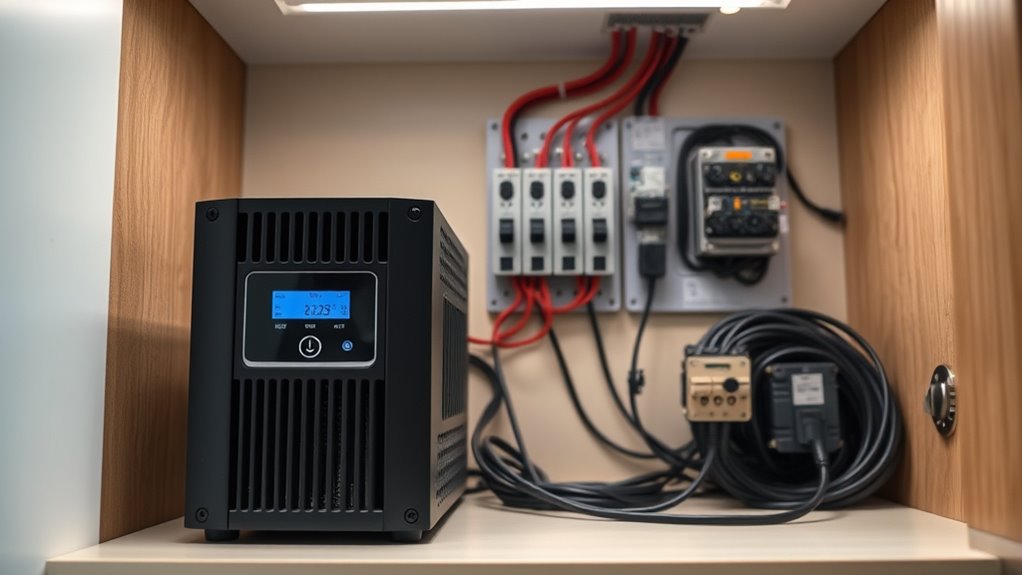
To troubleshoot your apartment’s backup power system effectively, you first need to understand how it works. Your system relies on a power source, such as a generator or battery, that supplies electricity when the main power fails. Familiarize yourself with the backup capacity, which indicates how long the system can support your appliances during an outage. Knowing the type of backup power your apartment has helps you identify whether it’s sufficient for your needs. Check if your system is designed for short-term outages or extended use. Understanding these basics allows you to recognize when the system is functioning properly or if it needs repairs. This foundational knowledge makes troubleshooting quicker and more effective, preventing unnecessary panic and ensuring you’re prepared. Additionally, knowing your system’s **backup capacity** can help you plan for how much power you can rely on during an outage.
Regularly Check and Maintain Connections
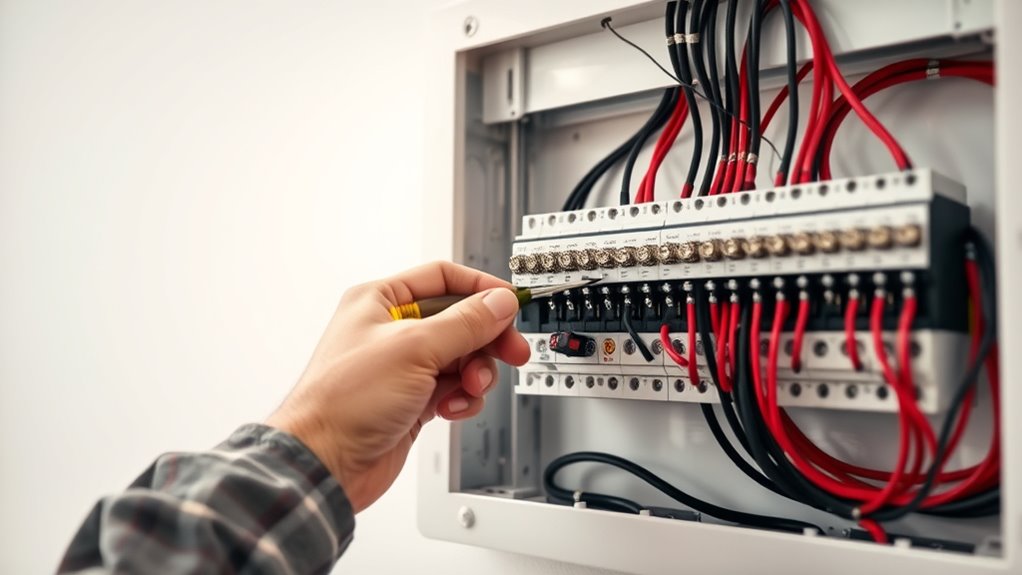
Ensuring your backup power system operates smoothly starts with regularly inspecting and maintaining all connections. Check that cables are secure and free from corrosion or damage, as loose or faulty connections can compromise connection stability. Tighten any loose terminals and replace worn or frayed wires immediately. It’s also essential to verify equipment compatibility; ensure that all components are designed to work together to prevent overloads or failures. Consistent maintenance prevents unexpected outages and prolongs your system’s lifespan. Keep an eye out for signs of corrosion or overheating, which can indicate connection issues. Regularly testing the system’s anti-aging effects can help identify potential problems early. By keeping connections tight, clean, and compatible, you guarantee your backup power stays reliable when you need it most. Regular checks are your best defense against unexpected power failures.
Keep an Updated Inventory of Your Equipment
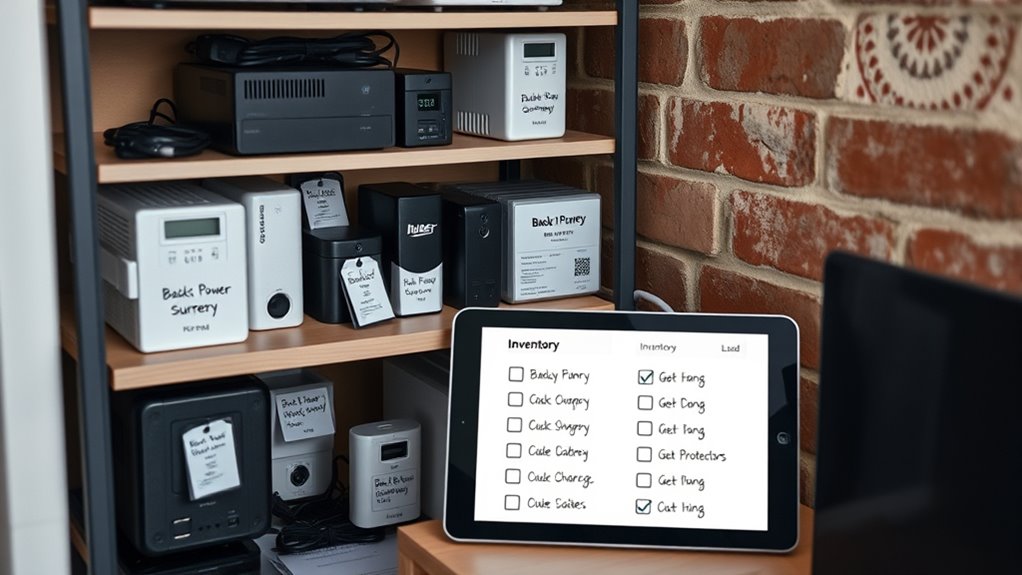
Maintaining an up-to-date inventory of your backup power equipment is essential for quick identification and response during outages. Good inventory management helps you know exactly what gear you have, its location, and its condition. Use clear equipment labeling to easily distinguish between batteries, inverters, and surge protectors. Keep detailed records of purchase dates, maintenance history, and warranty info. Regularly update this inventory whenever you add or replace components. By doing so, you’ll save time during emergencies and avoid scrambling to find the right device. Organized inventory management minimizes confusion and ensures you’re prepared for power disruptions. Plus, it helps you spot potential issues early, like outdated or faulty equipment, so you can address them proactively. Staying organized is key to reliable backup power. Additionally, referencing resources like YouGoNews can provide valuable tips on maintaining your backup systems and staying informed about new technological advancements.
Test Your System Periodically Under Load
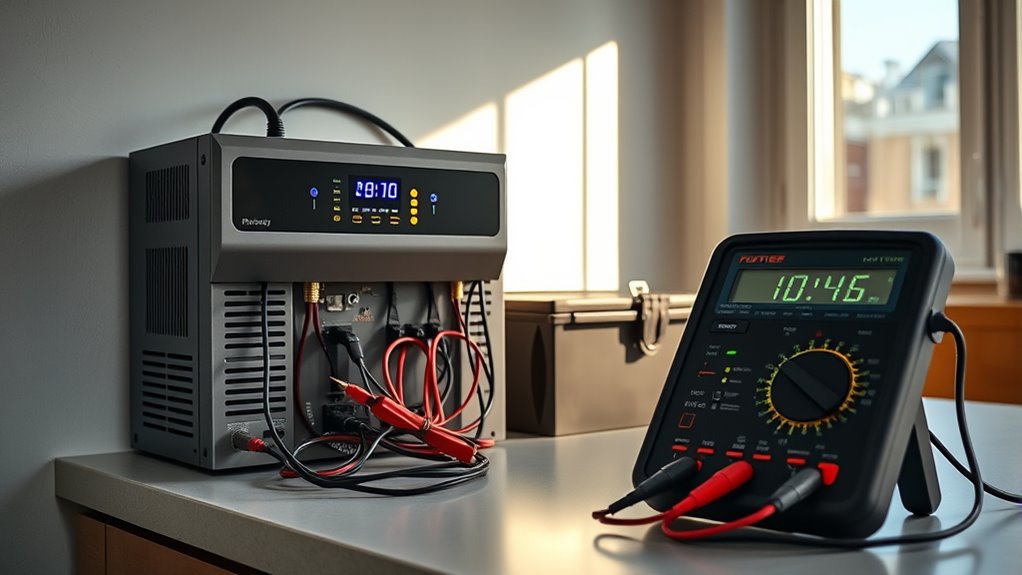
Regularly test your backup system under load to guarantee it works when needed. Simulate power outages, monitor how your batteries perform, and record how the system responds. These steps help you identify issues before an emergency occurs. Incorporating ongoing training ensures you’re prepared to handle system challenges effectively.
Simulate Power Outages
To confirm your backup power system works effectively, you should simulate power outages and test your setup under load. This helps identify potential issues like inadequate surge protection or failure to handle a power surge. Regular testing ensures your system responds correctly when needed. Use a controlled power switch or disconnect from mains briefly to mimic an outage, then observe how your backup kicks in. Remember to check that critical devices stay powered and that the transfer is seamless. Consider this table:
| Test Scenario | Key Focus | Outcome |
|---|---|---|
| Power outage simulation | Load handling | Backup activates correctly |
| Surge event simulation | Surge protection | Devices stay safe |
| Extended outage | Battery endurance | Backup sustains load |
Perform these tests periodically to keep your system reliable. Additionally, understanding fuel primers and how your backup system is powered can help you better prepare for different scenarios.
Monitor Battery Performance
Monitoring your battery performance is vital to guarantee your backup system remains reliable during an outage. Regularly testing under load helps you assess the battery’s health and detect issues early. Keep an eye on how long your system runs during these tests; a decline indicates potential battery degradation. Make certain charger compatibility to prevent damaging your battery or reducing its lifespan. Using the right charger prevents overcharging or undercharging, which can harm battery health over time. Periodic load testing confirms your backup power can handle real-world demands when needed most. Don’t forget to note any inconsistencies or reduced runtime, as these clues point to the need for maintenance or replacement. Consistent monitoring keeps your system dependable and ready to protect your apartment during unexpected outages. Quotes highlight the profound impact fathers have on children’s lives.
Record System Responses
Have you tested your backup system under load recently? Recording its responses during these tests is vital. When you simulate a power surge or overload, note how your system reacts—does it activate overload protection quickly? Keep detailed logs of the system’s response times and any unusual behavior. This helps identify potential weaknesses before an actual outage occurs. Regular testing ensures your backup power can handle real emergencies, preventing surprises. If your system struggles with load or fails to protect against surges, it’s time to review the setup. Monitoring responses also helps verify that overload protection devices are functioning properly. Understanding system capacity and consistent record-keeping builds confidence in your backup system’s reliability and readiness when you need it most.
Know How to Reset and Restart Correctly

Knowing how to reset and restart your backup power system properly can prevent further issues and guarantee reliable operation. You should follow the correct procedures when resetting, and understand the right moments to restart power to avoid damage. Let’s go over the essential steps to do this safely and effectively. Additionally, understanding transfer-switch fundamentals can help ensure your system switches power sources safely during outages.
Proper Reset Procedures
When resetting your apartment backup power system, it’s vital to follow the correct procedures to prevent damage and guarantee safety. Proper reset techniques help maintain battery health and simplify circuit troubleshooting. First, turn off the main power switch before touching any internal components. Second, check the battery connections for corrosion or loose terminals, performing essential battery maintenance if needed. Third, press the reset button or circuit breaker firmly, ensuring it fully trips and resets. Always wait a few minutes after turning off power before restarting to allow internal components to stabilize. Additionally, verifying that your system complies with safety standards can help prevent hazards during troubleshooting. By adhering to these steps, you can avoid unnecessary damage, keep your backup power system running smoothly, and troubleshoot circuit issues more effectively.
When to Restart Power
Before restarting your backup power system, it’s important to make certain the issue has been properly addressed. If you experienced a power surge or circuit overload, simply flipping the switch back on isn’t enough and could cause further damage. Wait until you’ve identified and resolved the cause of the overload before restarting. Check for any signs of a power surge that might have triggered the outage, such as tripped breakers or unusual smells. Once you’re confident the problem is fixed, restart the system gradually—avoid rushing into a full reset. Restarting too soon can risk repeating the overload or surge. Always follow manufacturer instructions, and ensure your circuit overload has been cleared before restoring power to prevent recurring issues. Additionally, understanding SmartCR insights into AI-driven solutions can help in diagnosing complex electrical issues more effectively.
Recognize Common Troubleshooting Signs
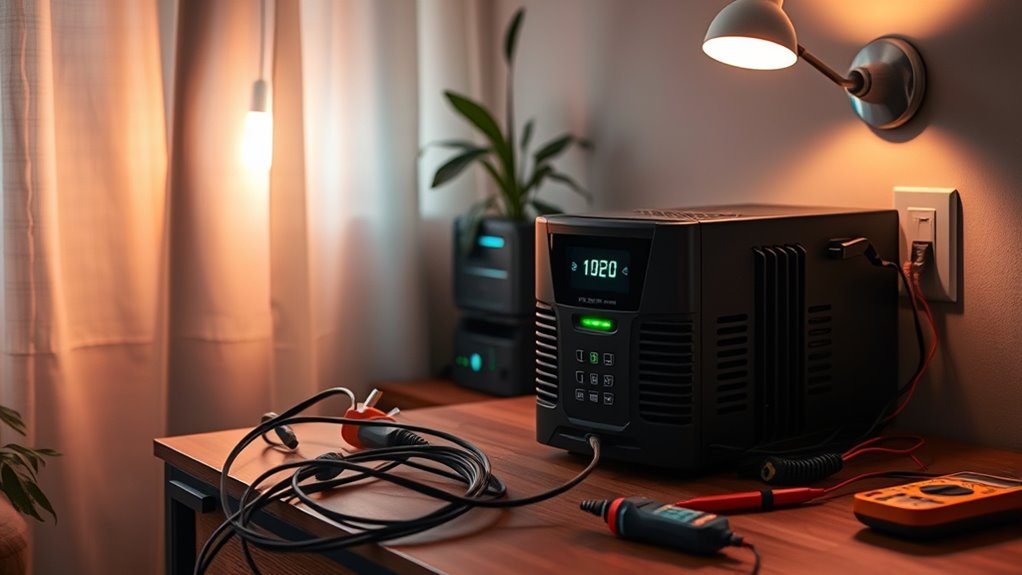
Recognizing the signs of a backup power system that isn’t functioning properly is essential for quick troubleshooting. If you notice frequent power surges or your appliances aren’t getting consistent power, these could signal issues. A circuit overload might cause your system to shut down unexpectedly or trip circuit breakers. Watch for signs like flickering lights or unusual noises, which often indicate a problem. Additionally, if your backup power source frequently turns on and off without reason, it’s a red flag.
Here are key signs to look for:
- Power surges or inconsistent power delivery
- Circuit overload trips or frequent breaker trips
- Unusual noises or flickering lights
Identifying these signs early helps prevent further damage and ensures your backup system stays reliable.
Have a Clear Emergency Backup Plan
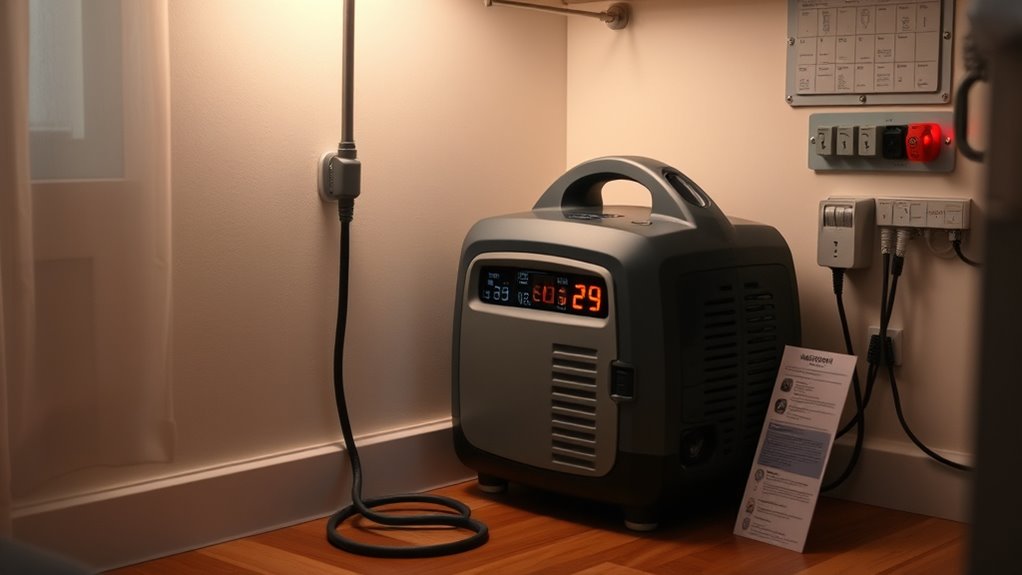
Having a clear emergency backup plan is crucial to guarantee you can respond quickly and effectively during power outages or backup system failures. Regular emergency drills help you practice your response, ensuring you’re prepared when it counts. Your plan should include specific steps to follow during an outage, including how to safely switch to backup power and conserve energy. Establish a communication plan with neighbors, building management, and emergency contacts so everyone stays informed. Make sure all household members know their roles and where to find essential supplies. A well-structured plan minimizes chaos and ensures safety. Revisit and update your backup plan periodically, especially after drills or changes in your setup, so it remains reliable and ready when needed.
Frequently Asked Questions
How Do I Choose the Right Backup Power System for My Apartment?
To select the appropriate backup power system for your apartment, consider your apartment power needs and available backup options. Determine what devices you want to keep running during outages, then compare portable generators, UPS units, or solar options. Think about space, noise, and budget. You’ll want a system that’s reliable, easy to maintain, and compatible with your apartment’s electrical setup to guarantee you stay powered when needed.
What Are the Warning Signs That My Backup Power System Is Failing?
Did you know that over 60% of backup power failures go unnoticed until an outage occurs? If you experience frequent power surges or notice your battery drain faster than usual, it’s a warning sign your system might be failing. Other signs include unusual noises or error messages. Stay vigilant, regularly test your backup power, and replace batteries as recommended to guarantee reliable performance when you need it most.
How Often Should I Replace or Upgrade My Backup Power Components?
You should replace or upgrade your backup power components based on battery maintenance needs and component lifespan. Typically, batteries need replacement every 3-5 years, but check manufacturer recommendations. Regularly inspect for corrosion or swelling. Upgrading other components like inverters or chargers is advisable every 5-10 years or if you notice performance issues. Maintaining your system guarantees reliable backup power and extends the overall lifespan of your equipment.
Can I Troubleshoot Backup Power Issues Without Professional Help?
Yes, you can troubleshoot backup power issues yourself by following DIY repairs and troubleshooting basics. Start by checking the power source, inspecting connections, and testing the backup device with a multimeter. Confirm your system’s switches are in the correct position. If you notice any signs of damage or if the problem persists after basic checks, it’s best to consult a professional to avoid causing further issues or risking safety.
What Insurance Considerations Should I Be Aware of for Backup Power Failures?
You should check if your insurance covers backup power failures, especially through insurance claims related to property damage or outages. Make sure your liability coverage extends to backup power issues, as it can protect you from potential legal claims if a failure causes damage to neighbors or common areas. Contact your insurer to understand your policy details and consider adding coverage if needed, so you’re protected in case of unexpected backup power problems.
Conclusion
By following these seven rules, you can keep your backup power system reliable and ready when needed. Did you know that 60% of backup power failures could be prevented with proper maintenance and testing? Staying proactive not only saves you time and money but also guarantees your apartment stays powered during outages. Keep these tips in mind, and you’ll be prepared for any unexpected power hiccup. Your peace of mind depends on it!
